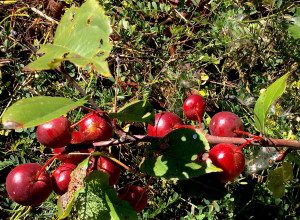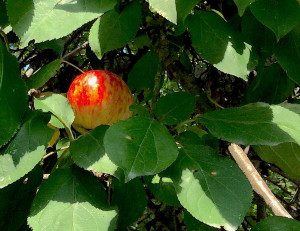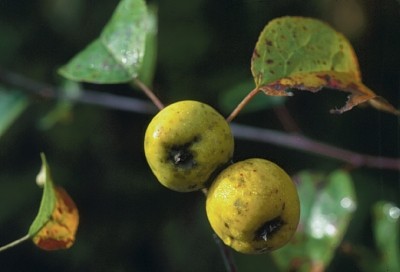
Wild Apples can be bitter.
September approaches and that means wild apples. I’ve never met a bad wild apple. There are sweet ones — edible off the tree — and there are bitter ones, often very good after roasting like a root vegetable. Nearly all apples are edible and are clones, well, at least commercial apples are clones. The experts tell us no two apple seeds are exactly alike. Granny Smith apple seeds will not product a Granny Smith apple. The first Granny Smith apple tree was a unique tree and was cloned, as were all the other named apples we buy in the store or grow at home. Cloning might not be exactly the right term: Cuttings were taken from that tree and grafted on to other apple trees. That’s why it took nearly a century for the Granny Smith apple to get from Australia to our markets in the United States.
What I noticed as a boy was the great variety of apple trees there were around the fields, old homesteads, and roads where I grew up. Near the house, where our horses could raid it, was an old small wild apple that had green fruit tasting tart to bitter. We made pipes out of the wood. But, the apples cooked well and the horses liked them as is, right off the tree with a few leaves. Just outside their fence there was a large (I suspect cultivated) tree with apples that tasted similar to a Golden Delicious. Across the dirt road from the house were five apple trees growing near the ditch, offspring of a tossed apple core and subsequent generations. And along a trail through the woods near a sand pit there was an old apple tree where one could usually find deer and or partridge feeding on the fallen fruit.
I thought of these while hiking the Appalachian Trail. Feral apple trees were common and good. I harvested apples every time I saw a tree. Not one tree looked as if anyone had bothered to collect any apples from them (low-hanging fruit was still low-hanging.) This latter observation is perhaps the most telling. Humans have been eating apples for some seven thousand years. They are one of the best known foods even among people who never forage. It is difficult to think of a food more recognizable than apples yet they remained unharvested along the trail and elsewhere. Even ardent must-get-back-to-nature types leave them alone. Maybe we are not as hungry as we think we are. I also see mangoes rotting on the ground often. To read more about apples, go here.
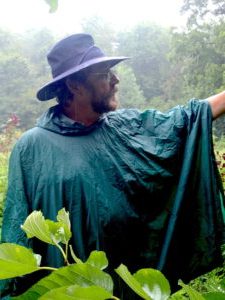
Classes are held rain or shine. Tropical storms and hurricanes are exceptions.
Foraging classes this time of year can be difficult to schedule because of pending storms. How much rain during a class is too much rain? I study the weather a couple of weeks out when scheduling class locations. As Sunday might be wetter near the est coast than Saturday we’ll do the east side of the state Saturday and the middle Sunday.
Saturday August 26th, Wickham Park, Melbourne Florida, 9 a.m. to noon. Meet at the dog park.
Sunday August 27th, Blanchard Park, Orlando, 9 a.m. meet beside the tennis courts.
For more information, to pre-pay, or to sign up of a class go here.
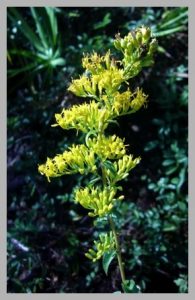
Some goldenrod tastes like anise. Photo by Green Deane
In blossom now is Goldenrod. It is a bit of a treasure hunt and disappointment. The treasure hunt is that one species is better than all the rest for tea, Solidago odora. It does grow here, has an anise flavor, but is hard to find. It’s reported in most counties but is not common. Goldenrod grows in about half of the United States, southwest to northeast. Other Goldenrod species can also be made into tea, perhaps all of them particularly for herbal applications, but they don’t taste anywhere near as good In fact, after the “Boston Tea Party” of 1773 halted tea imports colonialists drank Goldenrod tea and even exported some to China. It did not catch on. However, every time I see a Goldenrod I pull off a leaf and crush it hoping to detect the tell-tale anise smell. It’s a golden treasure hunt.The edible seeds and skinny roots taste like raw potato.
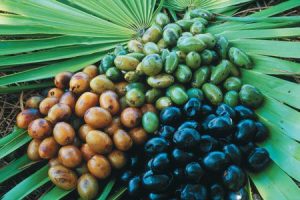
Saw Palmetto berries go from green to gold to black.
The “revolting” flavor of ripe Saw Palmetto berries will soon be upon us. I’m not sure they are an “acquired” taste or a tolerated one. You will either be able to eat them or not. Basically they tastes like vomit. To be a little more gracious they taste like an intense blue cheese with some burning hot pepper tossed in. Once you get used to them they are… endurable. But if you were hungry you would crave them in that they have all the amino acids humans need to be healthy. They are good for you even if you don’t like them and should be on the top of every vegetarians list of go-to plants. As with some fruit — Durian for example — the smell is enough to dissuade many people from eating them, hungry or not. Saw Palmetto berries will be ripening for the next few weeks. They start out green, turn to gold this month, then ripen to black, usually in September. If you are adventurous you have been forewarned.
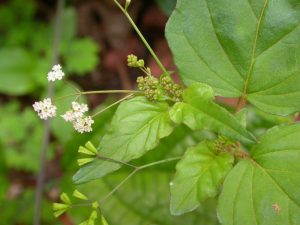
Boerhavia erecta, a Florida native.
As mentioned above foraging is like treasure hunting. While pedaling once in Apopka I had to stop at an intersection and noticed some Boerhavia diffusa. It’s a common barely edible probably from India or near there. One usually finds it in somewhat trashy ground such as sidewalk cracks, parking lots, and dumps. So when I stopped at the intersection it was no surprise to see Boerhavia growing there. But growing next to it was a white Boerhavia. That I had never seen. And the leaves were more pointed than the common species. A little bit of research suggests I found B. erecta, which surprisingly is a Florida native. It has spread to other parts of the world, however, and is reportedly edible and medicinal like B. difussa. After a bit more research I might have to update my article on the species. Until then you can read about the ruby-blossomed B. diffusa here.
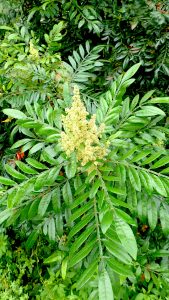
Sumacs are in blossom. Photo by Green Deane
What is that? It’s a common question locally now that sumacs are in bloom. Their creamy terminal blossoms stand out looking somewhat exotic among the dark green foliage. The most common species here is Winged Sumac which is also one of the most widely-distributed sumac in North America. It is also the only known plant source of B12, but only about 10 mg per kilo of fruit. Sumac found nearly everywhere though in different locales other species may dominate. Where I grew up in Maine Staghorn Sumac was the common species and grew quite tall. I see them often when I visit North Carolina. The key to making sure you have an edible sumac and not toxic Poison Sumac or Brazilian Pepper is location of the blossom and subsequent fruit. Edible sumacs have terminal clusters of medium to dark red berries covered with fine hair. In this case “terminal” means they are on the very end of the branch, like the blossom on the left. Brazilian Pepper has pink berries that are further down the branch. Poison Sumac, which only grows only in wet places, has dull cream to green-cream berries also further down on the stem. To read more about sumacs go here.

You get the USB, not the key.
150-video USB would be a good end of spring present and is now $99. My nine-DVD set of 135 videos has been phased out. The USB videos are the same videos I have on You Tube. Some people like to have their own copy. The USB videos have to be copied to your computer to play. If you want to order the USB go to the DVD/USB order button on the top right of this page. That will take you to an order form. I’d like to thank all of you who ordered the DVD set over the years which required me to burn over 5,000 DVDs individually.

Green Deane Forum
Want to identify a plant? Perhaps you’re looking for a foraging reference? You might have a UFO, an Unidentified Flowering Object, you want identified. On the Green Deane Forum we — including Green Deane and others from around the world — chat about foraging all year. And it’s not just about warm-weather plants or just North American flora. Many nations share common weeds so there’s a lot to talk. There’s also more than weeds. The reference section has information for foraging around the world. There are also articles on food preservation, and forgotten skills from making bows to fermenting food.
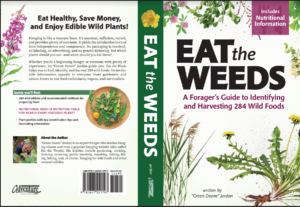 is EatTheWeeds, the book. It should have 275 plants, 350-plus pages, index and color photos. Several hundred have been preordered on Amazon. Most of the entries include a nutritional profile. Officially it will be published Dec. 5th (to suit the publisher publicity demands) apparently to appeal to the winter market but can be delivered by mid-October
is EatTheWeeds, the book. It should have 275 plants, 350-plus pages, index and color photos. Several hundred have been preordered on Amazon. Most of the entries include a nutritional profile. Officially it will be published Dec. 5th (to suit the publisher publicity demands) apparently to appeal to the winter market but can be delivered by mid-October
This is weekly newsletter #570. If you want to subscribe to this free newsletter you can find the sign-up form in the menu at the top of the page.
To donate to the Green Deane Newsletter click here.

